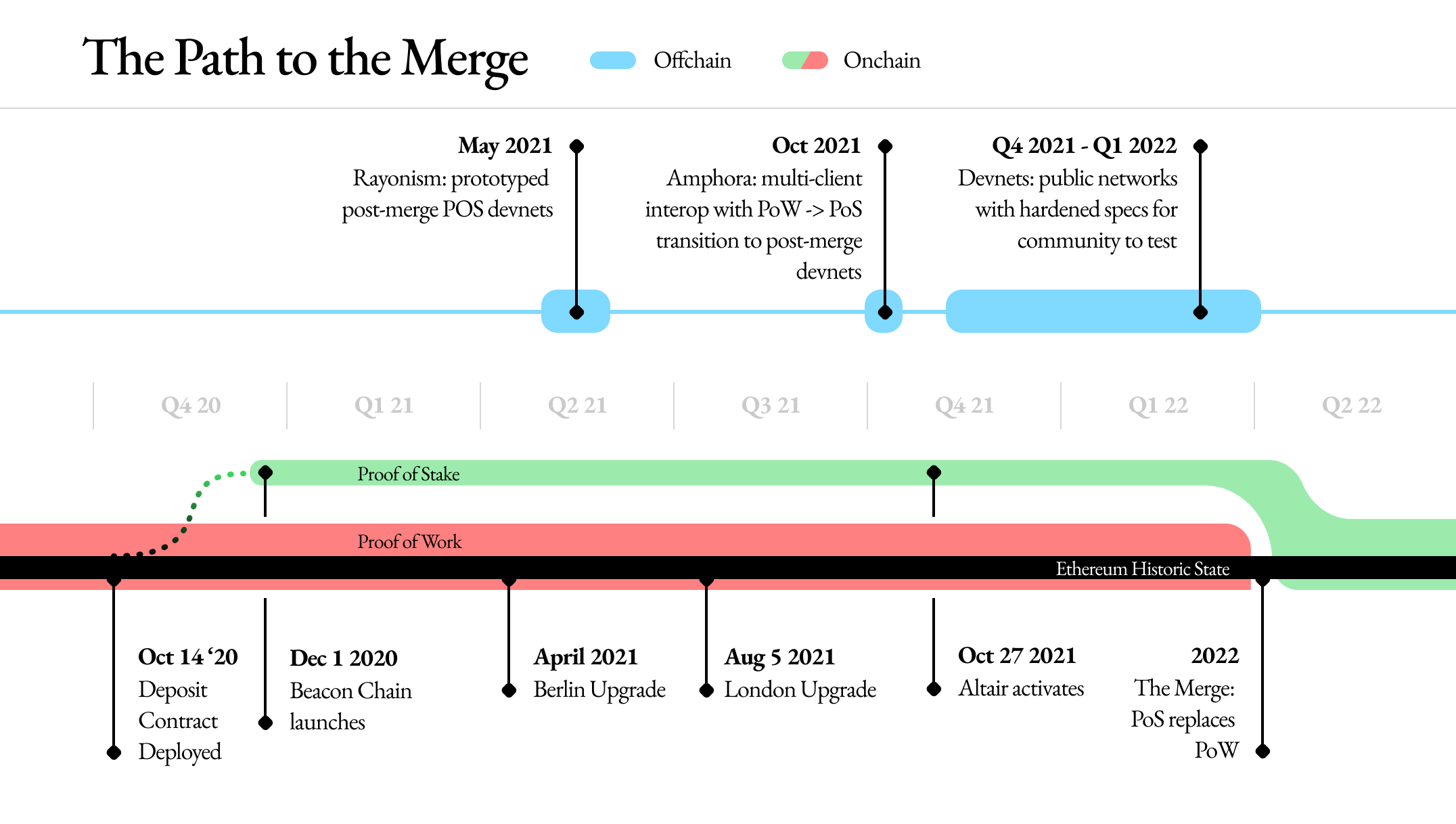Earlier this yr, the Rayonism hackathon kicked off to protoype the structure for Ethereum’s transition to proof of stake. The transition, typically refered to as The Merge, will maintain the present beacon chain (eth2) and execution layer (eth1) shoppers, and “merge” each chains by making the beacon chain drive the execution layer’s consensus. This method is the latest in a collection of iterations to the Ethereum roadmap (extra on that here).
Whereas Rayonism proved that this was a sound structure, there have been nonetheless a number of issues left to design, implement and take a look at, together with the precise proof of labor (PoW) to proof of stake (PoS) transition. To take action, consumer groups met head to head final week (analogous to the Eth2 Interop from 2019) for a workshop named Amphora 🏺.
Right here is an summary of the principle issues that have been completed in the course of the workshop, and the trail from right here to The Merge.

Amphora Milestones
The aim of the occasion was to get the execution and consensus layer consumer groups to iron out excellent points within the specification and attain a set of improvement milestones. Every milestone bought shoppers nearer to a totally functioning merge devnet which transitioned from PoW to PoS. Representatives of Besu, Erigon, EthereumJS, Geth, Nethermind, Nimbus, Lighthouse, Lodestar, Quilt and Teku attended the workshop in individual. The Prysm workforce, together with a number of members from the aforementioned groups, participated remotely.
The Amphora Milestones aimed to first get shoppers conforming with the spec, then regularly including extra complexity and at last rising the quantity of different shoppers they might interoperate with.
The primary milestone, M1, solely required shoppers to implement the merge specification. It was accomplished by most groups previous to the workshop even beginning! To assist shoppers validate their implementation, several – testing – suites have been supplied.
Then, milestones M2, M3 and M4 had consumer groups arrange devnets with an growing technical complexity and node range. M2 had execution layer (EL) and consensus layer (CL) groups pair one on one, and launch a post-merge devnet. This ensured that each layers might efficiently talk by way of the Engine API in a PoS context.
M3 is the place the Amphora workshop moved a step past Rayonism: shoppers arrange emphemeral devnets which ran by the PoW to PoS transition.
The transition is predicated on PoW issue: as soon as a block’s issue equals or exceeds a particular worth, known as TERMINAL_TOTAL_DIFFICULTY, or TTD, it’s thought-about the ultimate PoW block. The execution layer then begins listening to the PoS consensus layer for brand new blocks. To make sure that every workforce’s implementation was sturdy, EL groups had to connect with two CL shoppers and vice-versa to go M3.
M4 was the actual goal for the occasion: to get a number of EL & CL shoppers on a devnet which went by the complete PoW to PoS transition. In different phrases, whereas M3 was about one-to-one devnets, M4 was about many-to-many.
We achieved this for a subset of the groups earlier than the tip of the workshop, so we then went for our stretch aim: M5.
Lasting Artifacts
This milestone aimed to show Amphora from a short-lived occasion to lengthy(er)-lived infrastructure that the neighborhood might use. M5 required consumer groups to start out a devnet that might not solely run by the complete transition with all consumer mixtures, however that might persist past the Amphora occasion.
On the final day of the workshop, minutes earlier than the ultimate dinner was served, M5 was hit: a community of 10,000 validators throughout 100 nodes and a number of other consumer implementations launched below PoW, reached the TERMINAL_TOTAL_DIFFICULTY, transitioned to PoS, and efficiently finalized the chain 🎉!

The M5 devnet efficiently finalizes post-merge, minutes earlier than the workshop’s closing dinner. Photograph by Ben Edgington.
Past Amphora
Amphora’s success offers nice momentum for The Merge. Consumer groups now have a clear list of tasks they should work towards, and sufficient progress has been made to start reaching out to a bigger section of the Ethereum neighborhood.
Yesterday, a extra secure model of the M5 Amphora devnet, Pithos, was launched. Now that this community is stay (explorer here), anticipate public calls exploring how developer instruments and different core Ethereum infrastructure can finest put together for the PoW to PoS transition.
Consumer groups and researchers will maintain iterating on The Merge specification to repair points recognized throughout Amphora and reply to suggestions from the neighborhood. Inside just a few weeks the spec must be finalized and, quickly after, a brand new secure testnet made accessible.
Thanks
The work completed throughout Amphora exceeded all of our expectations. For this, we need to thank the consumer groups and researchers, with out whom, not one of the specs would have been written or carried out.
Additionaly, due to ConsenSys, Chainsafe and Ben Edgington for his or her glorious protection of the workshop.
















